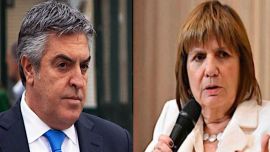As if producing another miracle just to make sure, the canonisation of the beatified María Antonia de Paz y Figueroa – more commonly known as ‘Mama Antula’ – will bring together two figures who, up until the presidential election, seemed irreconcilable: President Javier Milei and Pope Francis.
As almost any Argentine will know, on the campaign trail, the outspoken libertarian economist verbally assaulted His Holiness, creating great tension with the Vatican. Following the election, it all seems to have quieted down, with Milei inviting the pontiff to visit his homeland. With confirmation of the date of the canonisation of the beatified woman from Santiago del Estero – scheduled for February 11 at St Peter’s Basilica – and President Milei’s office stating the libertarian leader will be at the Vatican to witness the religious ceremony, relations could be warming up.
At the heart of this change lies Mama Antula – but who was María Antonia de Paz y Figueroa, the beatified woman who will become the first Argentine female saint?
Backstory
Mama Antula, diminutive for Madre Antonia in Quechua, was born in 1730 in a Santiago del Estero family. She spoke Quechua and would evangelise aboriginal communities together with the members of the Society of Jesus, before they were expelled, according to the AICA Catholic news agency and portal.
The back-story of the beatified woman tells us that she travelled nearly 5,000 kilometres around the Viceroyalty of Peru, around what today is known as the provinces of Santiago del Estero, Tucumán, Salta, Jujuy, Catamarca, La Rioja and Córdoba. When Buenos Aires became the centre of the Viceroyalty of Río de la Plata, Mama Antula settled there, performing spiritual exercises according to St Ignatius and helping to build one of the oldest buildings in town: the Holy House of Exercises (1795), which still stands today.
Defying conventions for a woman of her time, she was also considered a Mother of the Homeland, since she would go on to perform spiritual exercises on such national heroes as Manuel Belgrano, Miguel de Azcuénaga and even Viceroy Santiago de Liniers, among others.
She died on March 7, 1799 in Buenos Aires.
Miracles
Mama Antula’s road to glorification began in 2010, when then-pope Benedict XVI considered her “venerable,” after acknowledging that “she practised Christian virtues to a heroic degree.”
In 2016, Mama Antula was beatified in Santiago del Estero, after Francis authorised the publication of a miracle due to the healing of María Rosa Vanina, a nun belonging to the congregation of the Daughters of the Divine Saviour.
The young nun had become healthy again in 1904 through the intervention of the founder and spiritual mother of the House of Spiritual Exercises of Buenos Aires.
The beatification helped Mama Antula become recognised in Argentine churches, where “an image of her could be placed,” explained Graciela Ojeda de Río, historian and disseminator of the beatified woman’s spiritual work.
Another essential step towards her sanctification took place on October 24 last year, when Pope Francis authorised Cardinal Marcello Semeraro, prefect Dicastery for the Causes of the Saints, to issue a decree on a miracle attributed to the intervention of Mama Antula.
At any rate, it was highlighted that – for the second step of the canonisation process – it was necessary to prove “another miracle, which if recognised by the Church, gives her the possibility of being canonised,” and recognised around the world.
The second miracle attributable to the soon-to-be saint took place in Santa Fe, with the healing of a man who suffered a stroke and whose prognosis of returning to normal life was “near impossible due to his cerebral lesions,” according to the Catholic news agency.
That is when both relatives and friends of the patient prayed asking for the intervention of the beatified woman María Antonia de San José, her Church name. After a few days, the man improved significantly and, after a few months of physical therapy, he was back to his normal self.
“The man’s medical history was sent to Rome to be assessed by nine different physicians from other parts of the world. The doctors consulted did not find a logical explanation for his recovery, the Vatican re-assessed it and established what [Jorge Mario] Bergoglio did, when he stated that said healing was due to the miraculous involvement of María Antonia,” concluded the historian.
Canonisation ceremony
Pope Francis will canonise María Antonia de Paz y Figueroa, also known as ‘Mama Antula,’ on February 11, during a ceremony at St Peter’s Basilica. She will become the first Argentine female saint.
The decision to beatify was approved by the Vatican last year, following approval of a miracle attributed to her intervention.
The Holy Father will lead the “Holy Mass and canonisation of beatified woman María Antonia di San Giuseppe de Paz y Figueroa” on February 11, which will begin at 9.30am (5.30am Buenos Aires).
The mass will be performed at the main chapel of St Peter’s Basilica, after the congregation of the Causes of the Saints published in October the approval of a miracle attributed to the “intervention” of María Antonia de Paz y Figueroa, known as the beatified woman of the Spiritual Exercises.
– TIMES/PERFIL/AGENCIES
related news
by Claudio Corsalini, with agencies




















Comments